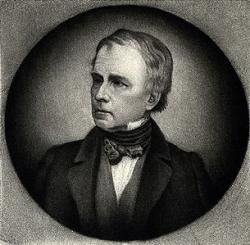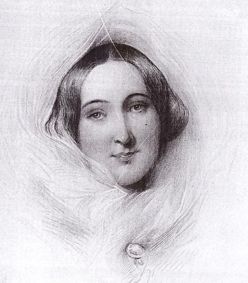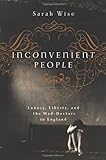
Gaslighting
Gaslight Stories: Wilkie Collins’s The Woman In White
Collins's novel was a vote of no confidence in lunacy laws drafted by his friend
Posted May 27, 2014
The 1850s were the high water-mark of the Victorian malicious lunacy incarceration phenomenon. In 1858, no fewer than four instances of deliberate attempts to certify and dispose of sane people (two women and two men) made national newspaper headlines. The most infamous of the four cases was the detention in a small private asylum near London of Rosina Bulwer Lytton. This had been arranged by her husband – novelist, playwright, MP and statesman Sir Edward Bulwer Lytton, an associate of both Wilkie Collins and Charles Dickens.
As a result of the 1858 scandals, a parliamentary Select Committee was convened, which sat in 1859 and reported at the end of that year and into 1860, with the newspapers following the evidence that was given. To say that Wilkie Collins (below) had chosen the right subject at the right time as the theme for a novel would be an understatement.

Wilkie Collins
(SPOILER ALERT! The plot of The Woman in White is an absolute cracker, and the paragraphs below give away the gist of the story!)
In brief, evil aristocrat Sir Percival Glyde intends to silence an eccentric young woman, Anne Catherick, who knows a secret about him; he also intends to get his hands on the inheritance of his wife, Laura Fairlie, by passing her off as dead. With his devilish accomplice Count Fosco, Sir Percival abuses the lunacy laws of England and arranges both a dodgy incarceration for Anne, who is only slightly ‘idiotic’ (to use the harsh language of Victorian medics); as well as a ‘body-swap’ that sees Laura supplant Anne in the insane asylum when Anne has died. The reason he can do this is because Laura and Anne look identical.
For a book that has the misuse of the lunacy certification and asylum admissions system at the heart of its plot, The Woman in White is in fact pretty vague about the mad-house involved – and the staff who run it. The asylum is placed somewhere to the north of London, and is a small private concern. The keeper himself is not an accomplice and is guilty of nothing more than taking in a patient who has been certified by two seemingly bona fide doctors. The asylum and lunatics/lunacy are not coloured-in by Collins because the real site of horror in the novel is the domestic home. The proprietor is a decent enough chap, and the asylum is presented as not a bad place in itself. But Collins didn’t need to make the asylum in itself horrific; the threat, or danger, that the institution represents is that this is where a person is stripped of personal freedom, civic rights and, in Laura’s case, legal identity.
A very good touch by Collins – innovative and accurate – is his portrayal of Laura as being changed both physically and mentally by her time at the asylum. The bewildering and disorientating ordeal of malicious incarceration could lead to the gradual erosion of personality and sense of self. Many real-life malicious incarceration plots worked in this way – place somebody sane and sensitive among the genuinely psychologically ill and watch as they too decline into what can be passed off as mental illness. ‘I feel my health is giving way,’ Rosina Bulwer Lytton wrote in July 1858 from her place of captivity, after just two weeks of incarceration. She had ‘terrible dreams, which have now haunted me for a fortnight – dreams that I am escaping over high walls and housetops.’
If they were lucky enough to win their freedom, victims of lunacy conspiracy were often shattered and broken by their stay among the insane and by being constantly disbelieved by the staff and proprietors of the asylum. As The Times newspaper put it, back in 1829 (following a notorious false incarceration trial), to a sane person, a lunatic asylum can appear to be a ‘hopeless prison, which is calculated to unsettle the steadiest intellect and to inflict agonies on the most cheerful spirit.’
Many of the individuals who contacted the two organisations who set themselves up to fight the legal cases of the wrongly certified admitted that they hadn’t been able to come forward for help earlier because they had been so devastated by the experience of having been put away sane into an asylum. It took months for some former inmates to feel emotionally strong enough to confront their conspirators; some – perhaps most – never came forward at all.
In The Woman in White, the normal, official route in freeing a sane patient in the 1850s is avoided. Here is what should have happened: a concerned person would contact the governmental inspectorate, the Commissioners in Lunacy, and explain the problem, requesting the Commissioners to visit the asylum, interview the alleged lunatic and make a decision either to free or to uphold the certification. Instead, in the novel, Laura’s half-sister, Marian, arranges an illegal ‘rescue’ of Laura, for expediency’s sake; Marian needs to act quickly because if Laura stays in the asylum any longer, she may well go mad. So, near ‘a quiet spot near the north wall’ and by pre-arrangement with a bribed asylum nurse, our heroine is led away from her captivity.
This avoidance of the official channel in the novel is a massive vote of no confidence by Collins in the Commissioners in Lunacy. And this is odd because Collins was on very friendly terms indeed with Commissioner Bryan Waller Procter (below). Procter had, in fact, co-drafted the landmark 1845 legislation on lunacy certification and admissions procedure (along with Lewis Carroll’s favourite uncle – lawyer Robert Wilfred Skeffington Lutwidge.) The Woman in White is even dedicated to Procter, which to me looks like something of a back-handed compliment – because one closes the novel feeling that the lunacy law of England in the 1850s was filled with terrifying loopholes (and, we may also fearfully wonder as we close the book whether we today are any less vulnerable to having our quirks and idiosyncrasies whipped up into an accusation of insanity).

Bryan Waller Procter
(I’m not sure if this is also a disguised dig, but Procter had lived for a few years at 5 Grove End Road, St John’s Wood, and Collins places Count and Madame Fosco’s home at no 5 in the fictional Forest Road, St John’s Wood: Grove? Forest? perhaps. . . )
Procter was a poet (writing under the pseudonym Barry Cornwall) and a literary ‘insider’. He had been suspected of being ‘Currer Bell’, the author of Jane Eyre, before Charlotte Bronte was eventually outed as its creator. Procter was also the dedicatee of William Makepeace Thackeray’s Vanity Fair; Thackeray, in 1842, had asked Procter to recommend a good private asylum for Thackeray’s genuinely psychologically ill wife, Catherine. Procter showed Thackeray ‘the best’, but Thackeray was horrified by what he saw there, writing: ‘It makes me quite sick to think of it even now. He [Procter] shook his head about other places.’ Another vote of no confidence in the English lunacy system, it would appear.
As a result of Procter’s legislation, from 1845 people with learning disabilities found themselves more likely to be certified into lunatic asylums, where before they had been cared for or tolerated within the community. ‘Idiots’ and ‘imbeciles’ were deemed to be ‘of unsound mind’, which placed them under the wider umbrella of ‘lunatic’. This put a borderline case such as Anne Catherick in a vulnerable position. When Fosco questions him on whether Anne is plausibly of unsound mind, Sir Percival replies: ‘She is mad enough to be locked away – just.’
Anne’s colluding mother insists on a private asylum for Anne, not a county asylum, where paupers are sent. And this is another revealing detail by Collins: the 1859 Select Committee on the lunacy laws made public in crude statistical detail how much harder it was to get discharged from a private asylum than from a county (ie state-run) one. In the state system, recovery and discharge rates ran at 37% of admissions – a figure that holds pretty steady across the nineteenth century. By contrast, if you were in a private asylum, discharge rates were a mere 10-14%. Of Chancery lunatics (that’s the very wealthiest and most socially elite group, whose affairs were overseen by the Lord Chancellor), only 1% found themselves at liberty again. Put crudely, the richer you were, the more reason there appeared to be to keep you under lock and key. Collins’s reading public would be aware that asylums run for profit and catering for those with cash were more likely to hold on to their patients than a county asylum keen to keep costs to a minimum by discharging promptly when sanity appeared to have returned.
To return to Rosina Bulwer Lytton, she was rather underwhelmed by The Woman in White. She wrote to Collins, ‘The great failure of your book is the villain. Count Fosco is a very poor one, and when next you want a character of that sort, I trust you will not disdain to come to me. The man is alive and constantly under my gaze. In fact, he is my own husband.’

Rosina (left) knew all these literary giants well, and believed that they were two-faced and disloyal to each other. She wrote: ‘After twenty-five years’ bitter experience [I know] that wherever the literary element enters, there camaraderie, expediency, clap-trap, treachery, moral cowardice and concrete meanness are sure to follow.’
True to form, Collins betrayed her by sending her letter straight to her husband; and true to form, Lord Lytton betrayed his ‘friend’ Collins by declaring The Woman in White ‘great trash’.
 Inconvenient People: Lunacy, Liberty, and the Mad-Doctors in England
Inconvenient People: Lunacy, Liberty, and the Mad-Doctors in England
by Sarah Wise
Counterpoint
FURTHER READING:
Jenny Bourne Taylor, In the Secret Theatre of Home: Wilkie Collins, Sensation Narrative and 19th-Century Psychology, 1988.
Rosina Bulwer Lytton, A Blighted Life: A True Story (autobiography), 1880.
Wilkie Collins, ‘A Fatal Fortune’, 1874. Based on the real-life malicious incarceration plot against wealthy heir James Tovey Tennent in the 1850s.
Barbara Fass Leavy, ‘Wilkie Collins’ Cinderella: The History of Psychology and The Woman in White’ in Dickens Studies Annual, Vol 10, 1982
Janet Saunders, 'Quarantining The Weak-Minded' in The Anatomy of Madness, vol 3, 1988.
Helen Small, Love’s Madness: Medicine, the Novel and Female Insanity, 1800-1865, 1996.
David Wright, Mental Disability in Victorian England: The Earlswood Asylum 1847-1901, 2001.
Website: Paul Lewis has compiled a fantastically comprehensive website dedicated to Wilkie Collins and his work at http://www.wilkiecollins.com/



